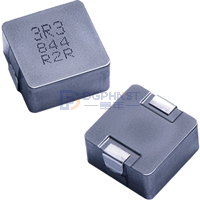Analysis of inductance characteristics of different classifications
Inductance, as a core component in circuits, has various classification methods. Different categories of inductors have significant differences in structure, materials, application scenarios, and performance characteristics. Starting from the classification dimension, combined with technical characteristics and application scenarios, the characteristics of various types of inductors are systematically sorted out.

1、 Classified by structure: from winding method to integrated design
fixed inductance
Single layer coil/multi-layer coil: made of insulated wires wound on paper tubes or rubberwood frames, with a simple structure and low cost, suitable for general filtering or oscillation circuits.
Honeycomb coil: The wire is folded and wound at a specific angle, with a small volume, low distributed capacitance, and high inductance. It is commonly used in high-frequency circuits.
Color coded inductance: The inductance is marked by a color ring and encapsulated in epoxy resin. It operates at frequencies ranging from 10kHz to 200MHz and is commonly used in RF modules.
Variable inductance
Copper core coil: By rotating the copper core to adjust the inductance, it has strong flexibility and is suitable for ultra short wave tuning circuits.
2、 Classification by operating frequency: differentiated requirements for high and low frequencies
High-frequency inductance
Features: Using ferrite or hollow coils, low loss, high Q value (quality factor), and small parasitic capacitance.
Application: High frequency scenarios such as 5G communication, IoT devices, TWS earphones, etc., demand drives global production capacity constraints.
Typical parameters: high self resonant frequency (usually>1GHz), low equivalent series resistance (ESR).
Low frequency inductance
Characteristics: Represented by I-shaped inductors and bar shaped inductors, it has a large inductance value and high saturation current.
Applications: power filtering, energy storage, high-power equipment (such as industrial controllers, automotive electronics).
3、 Classified by core materials: Performance game of magnetic materials
Hollow core inductor
Features: No magnetic core, good linearity, no hysteresis loss, suitable for high-frequency or high-power scenarios.
Limitations: Low inductance, requiring increasing the number of turns to enhance the inductance value.
Ferrite inductor
Features: High magnetic permeability, low loss, suitable for high-frequency filtering (such as EMI filters).
Application: Switching power supply output filtering, RF interference suppression.
Iron powder core/iron silicon aluminum powder core inductor
Features: High saturation magnetic flux density (iron silicon aluminum powder core can reach 15000 Gauss), low loss, excellent temperature stability.
Applications: PFC (Power Factor Correction) circuits, resonant inductors, high power density power supplies.
Amorphous nanocrystalline alloy magnetic core inductor
Features: High magnetic permeability, low iron loss, suitable for high-frequency and high-efficiency design.
Application: The miniaturization needs of modern communication and power electronic devices.
4、 Classification by packaging form: Process differences between SMT and plug-in
Surface mount inductors (SMD)
Chip inductor: flat winding+magnetic material, small size, suitable for automated mounting, widely used in consumer electronics (mobile phones, tablets).
Integrated inductor: The winding is embedded in metal magnetic powder and die cast, with good heat dissipation, suitable for high-power density scenarios.
Plug in inductor
I-shaped inductor: With a large volume and sufficient winding space, it can withstand high currents and is commonly used in industrial power supplies and automotive electronics.
Loop inductor: Closed magnetic circuit design, good EMI performance, but requires manual winding, resulting in high cost.
5、 Classified by purpose: Function oriented customized design
Power inductor
Features: High current processing capability (usually>10A), low DC resistance (DCR), excellent heat dissipation performance.
Applications: DC-DC converters, switching power supplies, electric vehicle battery management systems (BMS).
Typical parameters: inductance range from 0.1 μ H to several mH, saturation current can reach tens of amperes.
filter inductance
Features: Suppress high-frequency noise, smooth current waveform, often combined with capacitors to form LC filters.
Applications: power input terminal, audio circuit, sensor signal conditioning.
Common mode inductor
Features: Dual line parallel winding or differential mode design, suppresses common mode noise, and improves EMI performance.
Applications: Communication equipment, medical electronics, industrial control systems.
6、 Key parameters and selection logic
Inductance (L): determined by the number of coil turns and magnetic core material, and needs to match the frequency requirements of the circuit.
Quality factor (Q value): High frequency inductors require a high Q value (>50), while low-frequency inductors can be appropriately reduced.
Rated current and saturation current: The power inductor needs to pay attention to the saturation current (usually 1.2 times the rated current).
Temperature characteristics: Materials such as iron silicon aluminum powder core and amorphous alloys have excellent stability within the range of -55 ℃ to+125 ℃.
The classification and characteristics of inductors are closely related to materials science, manufacturing processes, and application scenarios. High frequency, miniaturization, and high power density are the current development trends of inductor technology, such as the popularity of chip inductors in consumer electronics and the key role of iron silicon aluminum powder core inductors in new energy vehicles. In actual selection, it is necessary to comprehensively consider circuit topology, environmental conditions, and cost objectives, such as:
High frequency scenario: Prioritize ferrite or amorphous alloy inductors, pay attention to Q value and self resonant frequency.
High power scenario: using iron silicon aluminum powder core or aluminum shell inductor to ensure heat dissipation and saturation current margin.
Cost sensitive projects: Color coded inductors or I-shaped inductors can provide cost-effective solutions.
